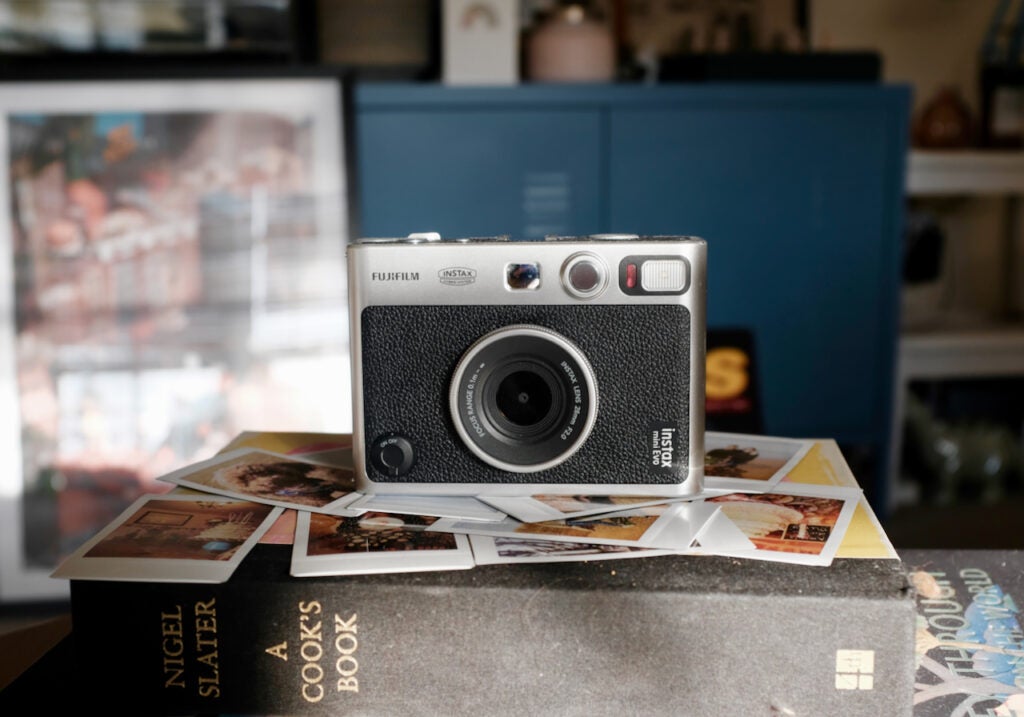
Fujifilm has officially unveiled its first new Instax camera of 2025: the Instax Wide Evo. Here’s how it compares to the Instax Mini Evo.
The Wide Evo is Fujifilm’s most versatile instant camera to date, bringing new Film Styles, a degree control dial and the widest angle lens yet to its Instax catalogue. It’s also the second Evo camera, launching four years after the existing Mini Evo.
Keep reading to learn how these two hybrid instant cameras compare.
Price
The Instax Wide Evo will be available to buy from February 4 with a suggested retail price of $349.95/£319.99. If you want a case with that, you’ll need to fork over an additional $49.95/£37.99.
The Instax Mini Evo, meanwhile, launched back in 2021. This camera carries an RRP of $199/£199.99, while a case will cost you $19.99/£24.99. This makes the Mini Evo the much more affordable of the two cameras, though neither is as cheap as Instax’ fully analogue cameras, such as the Mini 12 or the Square SQ40.
The Instax Mini Evo is more compact
If you prefer a smaller camera that might be slightly easier to slip into a small bag (or a large pocket), the Instax Mini Evo is your winner.
The Mini Evo is a compact instant camera that measures 122.9 x 87 x 36mm and weighs just 285g. The Instax Wide Evo, on the other hand, measures 125 x 138.7 x 62.8mm and weighs nearly twice as much at 490g.
One benefit to the larger size of the Instax Wide Evo is that it also makes room for a slightly larger 3.5-inch TFT LCD display, while the Mini Evo includes a 3-inch TFT LCD display. Both screens have an approximately 460,000-dot resolution.


The Instax Wide Evo features Instax’ widest lens yet
Of course, the size of the camera depends on the size of the lens, as well as the side of the film it’s intended to print
The Instax Wide Evo is equipped with the brand’s widest-angle lens to date, making it possible to capture a wider view of your scene and squeeze more people into group pics with the optional Wide-angle Mode accessible with the flip of a switch. Where the Wide Evo has a focus distance of 16mm (35mm equivalent), the Mini Evo has one of 28mm (35mm equivalent).
Film size is where many might base their buying decision, with the Wide Evo printing large, landscape orientation shots with a film size of 86 x 108mm and an image size of 62 x 99mm. The Mini Evo, meanwhile, is designed to deliver smaller, credit card-size photos snapped in a portrait orientation with the film measuring 86 x 54mm and the image spanning 62 x 46mm.
Of course, both cameras can be rotated 90 degrees to shoot portrait or landscape, but the chunkier bottom border sits on a different edge for these two instant cameras.
The Instax Wide Evo has new Film Styles
Both the Instax Wide Evo and the Instax Mini Evo take advantage of 10 Lens Effects (such as Light Leak, Double Exposure and Vignette) and 10 Film Effects (such as Warm, Vivid and Monochrome) which can be combined to produce unique looks and previewed on the LCD display before you snap your image.
The Instax Wide Evo also includes a new addition known as Film Styles. These are essentially frames available to add an extra layer of creativity around the edges of your images. There are six Film Styles to choose from: Normal, Cinematic, Date Stamp, Collodion Process, Contact Sheet and Film Strip.


The Instax Wide Evo controls effects with a twist
The Instax Wide Evo also includes a new degree control dial around the lens, allowing you to access different variations and degrees of each effect.
We were told there are around 100,000 possible effect combinations you can achieve when you fiddle with Lens Effects, Film Effects, Film Style and the degree control dial, making it unlikely you’ll snap exactly the same shot as another Wide Evo photographer, even if you aim the camera at the same subject.
Early verdict
The Instax Mini Evo is a fantastic hybrid camera designed to give instant photographers plenty of flexibility when shooting, both when it comes to the appearance of an image and whether or not it gets printed.
The Wide Evo takes this a step further with new Film Styles and the degree control dial, though the size of the camera isn’t quite as travel (or wallet) friendly.
You’ll have to wait for our full review of the Instax Wide Evo to hear our final verdict on the camera, along with how it compares to the Mini Evo.






